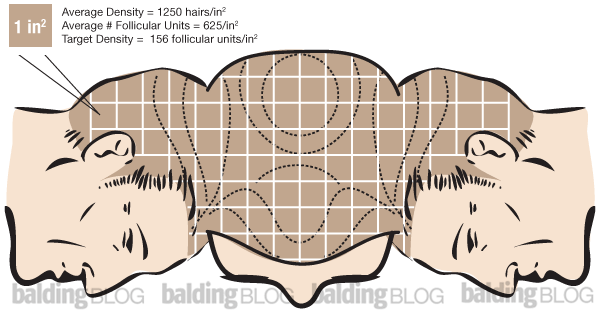Reprinted from the New Hair News, Vol. 12, 2007.
Click here to request your free copy, included with the “complete information package”.
—
People always ask, “How many grafts will I actually need to have transplanted?†Time and time again, that graft number answer will vary by doctor. When a doctor recommends a certain number of hairs/grafts, the doctor’s experience and his/her artistic skills are used to estimate what it might take to fill in the balding area with enough fullness to meet the person’s needs. I have seen estimates that could be a four fold difference and when you are shopping for a hair transplant, the differences in the estimating abilities of the doctors can be very unsettling. Who do you believe? Clearly you want to believe the doctor who has the lowest estimate for hair moved (transplants are priced by the graft), but then you are locking yourself into what might become a never ending series of hair transplant surgeries with an unrealistic amount of hair transplanted that may not meet your goals.
Does your doctor have the necessary artistic ability, not just to estimate the number of hairs/grafts, but also to take advantage of the hair supply to create a distribution that maximizes the value of the transplants for the most fullness? We have put some factors together to address how a surgeon actually calculates the numbers of grafts. These factors may not apply equally to all people. No two people are the same. The various factors like the thickness of the individual hair shafts (coarse vs. fine hair), the character of the hair (curly vs. straight hair), the color of the hair and the skin (the closer the match, the more full appearance of the hair), and any special needs defined by the patient, make us very different. On white skinned people, those with blonde hair have a fuller look while those with black hair will have a more ‘see through’ appearance. The blonde haired man, the very fine haired man, or the very bald man who has a hair supply that might not be adequate to cover the bald area will be different in their needs for fullness. When the calculations are not clearly evident, it is the doctor’s art that saves the day to maximize the value of the hair transplants that are received. We generally try to restore 25% of the original hair density in a ‘typical’ patient. Some people may require more than 25% of the original density and if you are one of these people, you should understand what you need and why you need it. Even if the overall achieved density is 25%, some areas may require more and some less than 25%. In people with fine or dark hair and light skin, a higher density than 25% of the original density is often required. In blondes with fair skin, less than 25% of the original density might meet the ‘fullness’ requirement. This is critical, because you look for fullness in the end result of the transplant process and it is the doctor’s art that addresses just how that fullness is to be achieved. Keep this in mind as you look to the analysis below.
The math for estimating number of grafts needed for a bald area:
We have proposed a 25% rule, which means that the balding person can go from a completely bald area to 25% of the original hair density that was there prior to the balding. The following calculation also assumes that the person used in this example has an average density of 2 hairs/mm2 (average density of a Caucasian). Every person is different, so the final number of grafts that will produce the fullness that a person wants to achieve (and can afford to purchase), are independent variables. These calculations were originally defined in a classic medical journal article written by Rassman in 1993 (Rassman, W.R.; Pomerantz, M.A. Minigrafts, the art and science. International Journal of Aesthetic and Restorative Surgery. 1(1): 27-36; 1993).
by William R. Rassman, M.D. and Jae P. Pak, M.D.

 As far as I know, insurance companies do not cover any drugs for male pattern hair loss, since it is a cosmetic issue from their point of view.
As far as I know, insurance companies do not cover any drugs for male pattern hair loss, since it is a cosmetic issue from their point of view.

 I am very concerned that you had a hair restoration procedure at such a young age, especially in the crown area and many doctors including myself might think that this is not an approach that an ethical doctor would do. Of course I do not have the luxury to examine you in person, but surgery is rarely recommend at such young age, particularly in the crown. More importantly, having surgery too early may actually accelerate hair loss and you may end up with negative (worse off) results. It sounds that way to me.
I am very concerned that you had a hair restoration procedure at such a young age, especially in the crown area and many doctors including myself might think that this is not an approach that an ethical doctor would do. Of course I do not have the luxury to examine you in person, but surgery is rarely recommend at such young age, particularly in the crown. More importantly, having surgery too early may actually accelerate hair loss and you may end up with negative (worse off) results. It sounds that way to me.